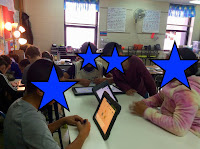We have "bilingual" groups established and we work in them almost daily, so I sent out a Jamboard to my students and assigned a specific page for each group to work on. From my perspective, as I was walking around the room I could see that everyone was either typing their ideas or discussing them. Side note: this RARELY happens, there is usually an argument or two that I have to referee in order for some groups to get through the task. After the 15 minute timer went off we convened on the carpet and this is what I heard from my students as we reflected on the day's lesson:
- "That was so much fun!"
- "Everyone participated this time!"
- "Mrs. Hegg, can we please NEVER go back to writing on boring Post-its?"
- "I love it when we use Jamboard"
Of course I won't say never to Post-its, but using Jamboard has really made a difference in my classroom. Those Jamboards that we created then became a resource for everyone, as they could access the information from all groups after sharing out, during their independent application time. As I settled in to work with a group of students I popped open my iPad and launched Apple Classroom just to check in and hold my students accountable for their independent work time.
This has proven necessary as many of them tend to wander on Safari instead of staying focused on the tasks for the day. To my surprise, I had 11 students on Jamboard using it as a resource while writing out their answers to the days prompt!! Score!!!











